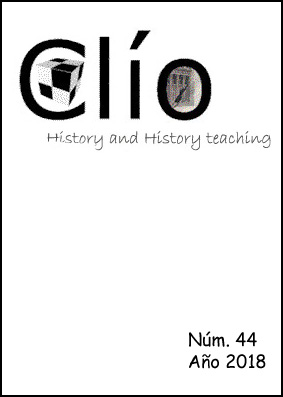Gamification and historical thinking construction: development of skills in gamified activities
DOI:
https://doi.org/10.26754/ojs_clio/clio.2018448671Keywords:
gamification, historical thinking, methodology, Big6, teaching historyAbstract
The disinterest of the students towards certain school subjects is a reality. In the case of Social Sciences, the prominence of a teaching based on transmissive aspects has increased this situation and has prevented the development of new work and intervention techniques that intensify the students' interest in historical and geographical concepts. One of the possible ways to change this situation is the insertion of gamified didactic sequences for the development of competences associated with historical thinking. Thus, in the present work we present an application scheme based on existing models that link the competencies and the way of presenting the information with the characteristics of the game or activity that one wishes to gamify. This model will help to promote didactic proposals that apply this methodology of work in the future.
Downloads
References
Bécares, L., Busto, M., y De Hoyos, C. (2016). Sentarse, escuchar y repetir. ¿Existe otra forma de enseñar historia? Ikastorratza.e-Revista de Didáctica, 16, 15-38.
Bel, J. C. (2017). Fantasía e imaginación: Estrategias para el trabajo del pensamiento histórico en educación primaria. En VV.AA. (Ed.), Investigación en didáctica de las ciencias sociales. Retos preguntas y líneas de investigación (pp. 341-348). Córdoba: Universidad de Córdoba.
Carbonell, J. (2015). Pedagogías del siglo XXI: Alternativas para la innovación educativa. Barcelona: Octaedro.
Carretero, M., Pozo, J. I., y Asensio, M. (Eds.). (1989). La enseñanza de las Ciencias Sociales. Madrid: Visor.
Chamoso, J. M., Durán, J., García, F., Martín, J., y Rodríguez, M. (2004). Análisis y experimentación de juegos como instrumentos para enseñar matemáticas. Suma, 47, 47-58.
Cuenca-López, J.-M., y Martín, M. (2010). La resolución de problemas en la enseñanza de las ciencias sociales a través de videojuegos. Íber. Didáctica de las Ciencias Sociales, Geografía e Historia, 63, 32-42.
Dicheva, D., Dichev, C., Agre, G., y Angelova, G. (2015). Gamification in education: A systematic mapping study. Educational Technology and Society, 18(3), 75-88. https://doi.org/10.1109/EDUCON.2014.6826129.
Eisenberg, M. B.; Berkowitz, R. E. (1990). Information Problem Solving: The Big Six Skills. Ohio: Linworth
Éthier, M. A., Demers, S., y Lefrançois, D. (2010). El desarrollo del pensamiento histórico de la literatura publicada en francés e inglés. Enseñanza de las ciencias sociales: revista de investigación, 9, 61-74.
Gaitán, V. (2013). Gamificación: el aprendizaje divertido. https://www.educativa.com/blog-articulos/gamificacion-el-aprendizaje-divertido/
Gajardo, M. (1993). Ivan Illich. Prospects, 23(3-4), 711-720. https://doi.org/10.1007/BF02195145
Guevara, J. M., y Colomer, J. C. (2017).Minecraft y Eduloc, en historia y geografía. Íber. Didáctica de las Ciencias Sociales, Geografía e Historia, 86, 16-23.
Huang, W. H., y Soman, D. (2013). Gamification Of Education. http://inside.rotman.utoronto.ca/behaviouraleconomicsinaction/files/2013/09/GuideGamificationEducationDec2013.pdf
Lee, J. J., y Hammer, J. (2011). Gamification in Education: What , How , Why Bother? Academic Exchange Quarterly. Academic Exchange Quarterly 15(2), 1-5.
McGonigal, J. (2013). Por qué los videojuegos pueden mejorar tu vida y cambiar el mundo?: un encuentro entre el mundo virtual y el real en el que las personas salen favorecidas. Madrid: Siglo XXI.
Pagès, J., y Santisteban, A. (2010). La enseñanza y el aprendizaje del tiempo histórico en Educación Primaria. Cad. Cedes, Campinas, 30(82), 281-309.
Rivero, P. (2017). Procesos de gamificación en el aula de Ciencias Sociales. Íber. Didáctica de las Ciencias Sociales, Geografía e Historia, 86, 5-6.
Rodríguez, F., y Santiago, R. (2015). Gamificación: Cómo motivar a tu alumnado y mejorar el clima en el aula. Madrid: Digital Text.
Sáiz, J. (2013). Alfabetización histórica y competencias básicas en libros de texto de historia y en aprendizajes de estudiantes. Didáctica de las ciencias experimentales y sociales, 27, 43-66.
Sáiz, J., y Colomer, J. C. (2014). ¿Se enseña pensamiento histórico en libros de texto de Educación Primaria? Análisis de actividades de historia para alumnos de 10-12 años de edad. Clío: History and History Teaching, 40, 1-19.
Santisteban, A. (2010). La formación de competencias de pensamiento histórico. Clio y Asociados, 14, 34-56. https://doi.org/10.14409/cya.v1i14.1674
Solbes, J. (2007). El desinterés del alumnado hacia el aprendizaje de la ciencia: implicaciones en su enseñanza. Didáctica de las ciencias experimentales y sociales, 21, 91-117. https://doi.org/10.7203/dces..2428
Soria, G. M. (2014). El pensamiento histórico en la educación primaria: estudio de casos a partir de narraciones históricas. Barcelona: Universitat Autonoma de Barcelona.
UNESCO. (1980). El niño y el juego Planteamientos teóricos y aplicaciones pedagógicas. Estudios y documentos de educación. Nueva York: UNESCO.
Downloads
Published
How to Cite
Issue
Section
License
Copyright (c) 2018 Alvaro Sánchez Segovia, Juan Carlos Colomer Rubio

This work is licensed under a Creative Commons Attribution-NonCommercial-ShareAlike 4.0 International License.
This work is licensed under a Creative Commons Attribution-NonCommercial-ShareAlike 4.0 International License.
Copyright remains the property of authors. Permission to reprint must be obtained from the authors and the contents of JoS cannot be copied for commercial purposes. JoS does, however, reserve the right to future reproduction of articles in hard copy, portable document format (.pdf), or HTML editions of JoS.






